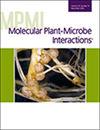Samodya K Jayasinghe, Natalia Moroz, Peiguo Yuan, Michael V Kolomiets, Kiwamu Tanaka
求助PDF
{"title":"水杨酸对马铃薯粉状痂病菌地下海绵孢的防御作用","authors":"Samodya K Jayasinghe, Natalia Moroz, Peiguo Yuan, Michael V Kolomiets, Kiwamu Tanaka","doi":"10.1094/MPMI-12-24-0154-R","DOIUrl":null,"url":null,"abstract":"<p><p>Potato powdery scab, caused by the soilborne pathogen <i>Spongospora subterranea</i> f. sp. <i>subterranea</i> (<i>Sss</i>), poses a significant threat to potato production, reducing potato value and impacting fresh market quality. Effective management strategies for this disease are currently lacking, and <i>Sss</i> is widespread in many potato-growing regions, highlighting the urgent need for effective control measures. Although the use of disease-resistant cultivars holds potential as a sustainable solution, the genetic mechanisms underlying resistance to <i>Sss</i> remain unclear. In this study, we investigated the role of the defense-related phytohormone salicylic acid (SA) in potato resistance to <i>Sss</i>. Initial analyses of defense gene expression revealed transcriptional reprogramming in response to <i>Sss</i> infection in potato hairy root cultures. Quantification of defense-related phytohormones further demonstrated a significant increase in SA levels in <i>Sss</i>-infected roots, whereas other phytohormones, jasmonic acid and ethylene, showed no substantial variation. Pretreatment of hairy roots with SA resulted in a marked reduction in <i>Sss</i> propagation, suggesting that SA contributes to induced resistance against the pathogen. To further elucidate the role of SA, we utilized transgenic potato hairy roots overexpressing the tomato SA receptor gene <i>SlNPR1</i> to enhance SA sensitivity or expressing the bacterial <i>nahG</i> gene to deplete endogenous SA. Our findings showed reduced <i>Sss</i> growth in <i>SlNPR1</i> overexpression lines, whereas <i>nahG</i> lines exhibited increased pathogen proliferation. These findings were further validated in fully grown potato plants using a pot assay. Collectively, our results indicate that SA plays a pivotal role in mediating resistance to powdery scab in potato. [Formula: see text] Copyright © 2025 The Author(s). This is an open access article distributed under the CC BY-NC-ND 4.0 International license.</p>","PeriodicalId":19009,"journal":{"name":"Molecular Plant-microbe Interactions","volume":" ","pages":"599-609"},"PeriodicalIF":3.4000,"publicationDate":"2025-07-01","publicationTypes":"Journal Article","fieldsOfStudy":null,"isOpenAccess":false,"openAccessPdf":"","citationCount":"0","resultStr":"{\"title\":\"Salicylic Acid Plays a Major Role in Potato Defense Against Powdery Scab Pathogen, <i>Spongospora subterranea</i> f. sp<i>. subterranea</i>.\",\"authors\":\"Samodya K Jayasinghe, Natalia Moroz, Peiguo Yuan, Michael V Kolomiets, Kiwamu Tanaka\",\"doi\":\"10.1094/MPMI-12-24-0154-R\",\"DOIUrl\":null,\"url\":null,\"abstract\":\"<p><p>Potato powdery scab, caused by the soilborne pathogen <i>Spongospora subterranea</i> f. sp. <i>subterranea</i> (<i>Sss</i>), poses a significant threat to potato production, reducing potato value and impacting fresh market quality. Effective management strategies for this disease are currently lacking, and <i>Sss</i> is widespread in many potato-growing regions, highlighting the urgent need for effective control measures. Although the use of disease-resistant cultivars holds potential as a sustainable solution, the genetic mechanisms underlying resistance to <i>Sss</i> remain unclear. In this study, we investigated the role of the defense-related phytohormone salicylic acid (SA) in potato resistance to <i>Sss</i>. Initial analyses of defense gene expression revealed transcriptional reprogramming in response to <i>Sss</i> infection in potato hairy root cultures. Quantification of defense-related phytohormones further demonstrated a significant increase in SA levels in <i>Sss</i>-infected roots, whereas other phytohormones, jasmonic acid and ethylene, showed no substantial variation. Pretreatment of hairy roots with SA resulted in a marked reduction in <i>Sss</i> propagation, suggesting that SA contributes to induced resistance against the pathogen. To further elucidate the role of SA, we utilized transgenic potato hairy roots overexpressing the tomato SA receptor gene <i>SlNPR1</i> to enhance SA sensitivity or expressing the bacterial <i>nahG</i> gene to deplete endogenous SA. Our findings showed reduced <i>Sss</i> growth in <i>SlNPR1</i> overexpression lines, whereas <i>nahG</i> lines exhibited increased pathogen proliferation. These findings were further validated in fully grown potato plants using a pot assay. Collectively, our results indicate that SA plays a pivotal role in mediating resistance to powdery scab in potato. [Formula: see text] Copyright © 2025 The Author(s). This is an open access article distributed under the CC BY-NC-ND 4.0 International license.</p>\",\"PeriodicalId\":19009,\"journal\":{\"name\":\"Molecular Plant-microbe Interactions\",\"volume\":\" \",\"pages\":\"599-609\"},\"PeriodicalIF\":3.4000,\"publicationDate\":\"2025-07-01\",\"publicationTypes\":\"Journal Article\",\"fieldsOfStudy\":null,\"isOpenAccess\":false,\"openAccessPdf\":\"\",\"citationCount\":\"0\",\"resultStr\":null,\"platform\":\"Semanticscholar\",\"paperid\":null,\"PeriodicalName\":\"Molecular Plant-microbe Interactions\",\"FirstCategoryId\":\"99\",\"ListUrlMain\":\"https://doi.org/10.1094/MPMI-12-24-0154-R\",\"RegionNum\":3,\"RegionCategory\":\"生物学\",\"ArticlePicture\":[],\"TitleCN\":null,\"AbstractTextCN\":null,\"PMCID\":null,\"EPubDate\":\"2025/6/12 0:00:00\",\"PubModel\":\"Epub\",\"JCR\":\"Q2\",\"JCRName\":\"BIOCHEMISTRY & MOLECULAR BIOLOGY\",\"Score\":null,\"Total\":0}","platform":"Semanticscholar","paperid":null,"PeriodicalName":"Molecular Plant-microbe Interactions","FirstCategoryId":"99","ListUrlMain":"https://doi.org/10.1094/MPMI-12-24-0154-R","RegionNum":3,"RegionCategory":"生物学","ArticlePicture":[],"TitleCN":null,"AbstractTextCN":null,"PMCID":null,"EPubDate":"2025/6/12 0:00:00","PubModel":"Epub","JCR":"Q2","JCRName":"BIOCHEMISTRY & MOLECULAR BIOLOGY","Score":null,"Total":0}
引用次数: 0
引用
批量引用

 求助内容:
求助内容: 应助结果提醒方式:
应助结果提醒方式:


